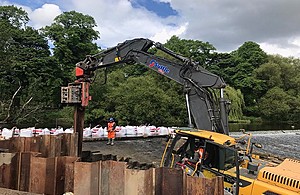Another leap forward in returning salmon to Yorkshire Dales
Seeing salmon leaping in the Yorkshire Dales is a step closer thanks to a major river restoration project tackling its next hurdle.

Work taking place to build a fish pass at Kirkstall weir as part of the Developing the Natural Aire project, which will see salmon returning to spawning grounds in the Yorkshire Dales
The Developing the Natural Aire (DNAire) project will see fish passes installed at the last four major obstructions blocking access up the river to the Dales.
Work to install a fish pass at Kirkstall weir has got under way with the building of a pontoon bridge across the river and a cofferdam.
This is being done in parallel with the construction of a fish pass at Saltaire weir, which began earlier this year.
The final two obstacles - Armley and Newlay weirs – will be made passable to fish later this year, with this part of the project expected to be complete by the end of the year.
Once complete it will allow passage for salmon up to spawning habitat in the upper Aire and its tributaries for the first time in more than 150 years.
It will also benefit other migratory fish, such as sea trout, eels and lamprey, as well as in-river coarse fish.
The £2.7 million project is led by the Environment Agency, delivered in partnership with Aire Rivers Trust and Yorkshire Water, and part funded by The National Lottery Heritage Fund, Yorkshire Water and Craven District Council.
Martin Slater, of the Environment Agency, said:
The safety of our staff, partners and the communities we work in remains a priority for us. We are following the latest Covid-19 guidance on safe working on construction sites from Public Health England.
As well as the re-opening the River Aire to fish migration, this project is an amazing opportunity to engage people with the river and reconnect them with its fascinating stories and the life within it.
The river’s heritage needs a sustainable future at the heart of communities and there is an opportunity to empower local people to take ownership and action to help care for this shared heritage into the future.
The River Aire is one of the longest rivers in Yorkshire, starting at Malham Tarn and flowing to meet the River Ouse near the Humber estuary.
In common with the many of the UK’s rivers, the Aire was adversely affected by the industrial revolution, both in terms of water quality and fragmentation of the watercourse.
Along with other industrialised rivers in the county it became instrumental in the making of modern Yorkshire; a place famed for cloth, coal and steel.
This industrial activity helped to shape Yorkshire as it is today, leaving behind a legacy of buildings, communities and stories that are part of the fabric of the communities surrounding the river.
But by 1840 it was said the River Aire was a “reservoir of poison, carefully kept for the breeding of a pestilence in the town”.
However, over the last 40 years, with the decline of the textile industry, investment by Yorkshire Water, tighter environmental legislation and pressure from interested groups, the water quality has steadily improved.
Dr Ben Gillespie, Yorkshire Water river resilience technical specialist, said:
Yorkshire Water is a proud partner of DNAire. We know that these projects benefit both the environment and our sustomers. Salmon, eel and other migratory fish will once again be able to access their historic spawning sites and complete their life cycles.
We expect this reinvigoration of the natural world to open up and enhance the economy of the Aire corridor, through increased tourism and angling opportunities.
On top of this, DNAire isn’t just about fish passes, and we look forward to seeing the outcomes of the community engagement and educational schemes planned and delivered by the Aire Rivers Trust.
Ultimately, DNAire will capitalise on historic investment in the Aire catchment by Yorkshire Water, and we look forward to seeing the results through working together in this Partnership project.
Aire Rivers Trust chairman Geoff Roberts said:
We are delighted to be part of this major project restoring the Aire to its former glory. Bringing salmon back to the river, and reconnecting the ecology for the benefit of many other fish species, has long been a dream of the Trust.
This project will catalyse a whole new interest in one of Yorkshire’s greatest rivers and we are already working with community groups along the river to regenerate interest.
Councillor Simon Myers, Craven District Council’s lead member for Enterprising Craven, said:
We’re delighted that work has started at Kirkstall weir on this exciting project. Craven District Council chose to support the development of this project with £150,000 from our New Homes Bonus Infrastructure Reserve, because we believe it will benefit communities and help create safe walking and cycling routes, as well as boosting tourism in the area.
| George Hinton | Communications Manager |
| Operational & Local Communications | Defra Group Communications |
| 07342 099 435 | [email protected] |